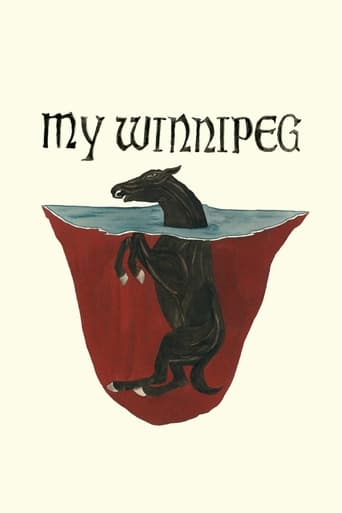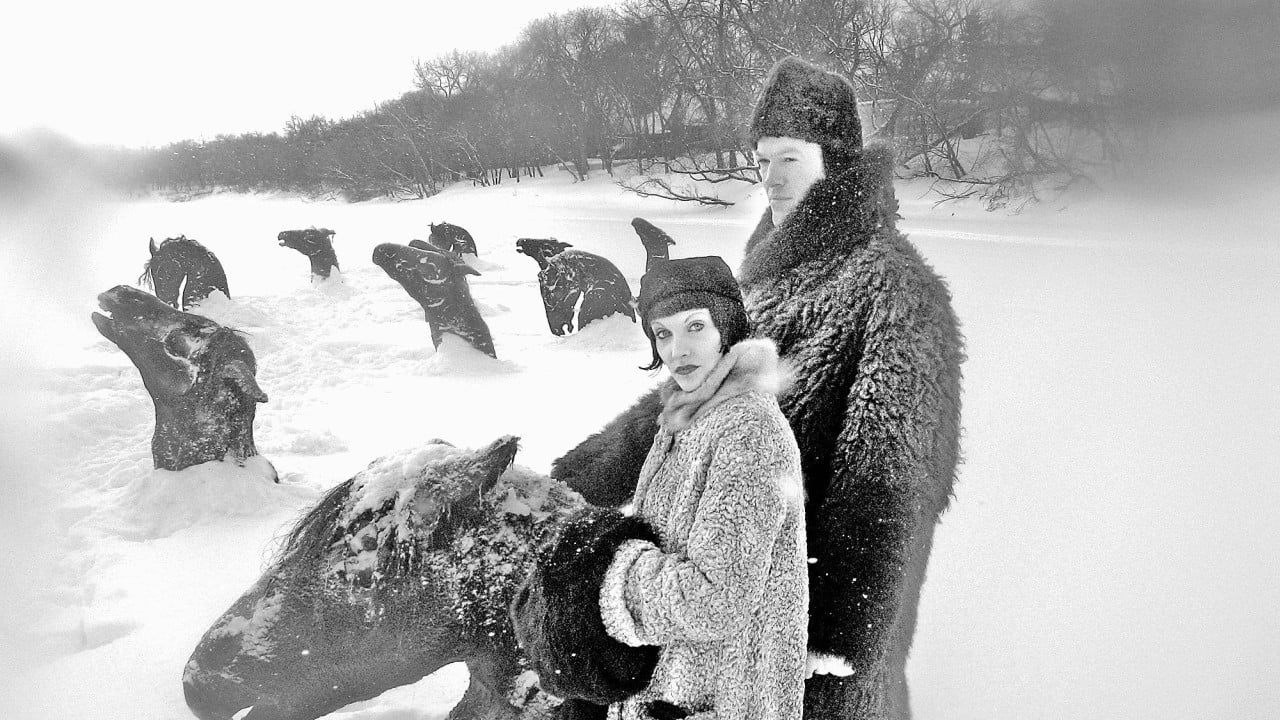gavin6942
Fact, fantasy and memory are woven seamlessly together in this portrait of film-maker Guy Maddin's home town of Winnipeg, Manitoba.The New York Times wrote that the film "skates along an icy edge between dreams and lucidity, fact and fiction, cinema and psychotherapy." Ebert wrote, "If you love movies in the very sinews of your imagination, you should experience the work of Guy Maddin." He is so right. The first Maddin I saw was "The Heart of the World" and I was hooked by his eye, making the new look old and the old look new.With this film, I wish I had been there (Winnipeg) to fully understand it. Maddin added a combination of poetry and "Christmas Story"-style narrative to give us the lowdown on a place that is always sleepy, always winter. (Being from Wisconsin, I can understand... at least to a point, as it is still almost 700 miles northwest of here. Those in Fargo probably understand better.)
Rectangular_businessman
Winnipeg, Manitoba, Canada, all those places has taken on life on the screen through this nostalgic mix of old silent films and documentaries, videos, photos and animations, most black and white, supported by the beautiful narration of the director Guy Maddin. The surrealist style of this movie works incredibly well, moving between the dreams, the memories and the reality, resulting in something incredibly beautiful and unique."My Winnipeg" is one of the most fascinating film experiences ever made. Even when it is certainly one of those movies that one either does hate or love, I consider "My Winnipeg" one of the most extraordinary works of love ever done in the history of cinema, being able to make all the places described or just mentioned in this movie a part of our memories and souls as viewers.
Andres Salama
This engaging, very personal tribute from weird Canadian director Guy Maddin to his hometown of Winnipeg is very well done. Shot in black and white with his familiar style that reminds one of both silent cinema and the films of David Lynch, the plot has an alter ego of the director hire his elderly, domineering mother (actually b-movie starlet from the 1940s Ann Savage) and actors playing his siblings in order to relive his teenage years in the sixties, and sort of understand what makes him tick. The movie includes a lot of lore about Winnipeg that may be true in some cases and is almost certainly not true in other cases (the story about the frozen horses' heads in the river, for example, is hard for me to believe). This deadpan, funny tribute is most of all a nostalgic paean to his childhood, and a denunciation of modern capitalism mindless drive to change all things (Maddin recounts in a heartfelt way how they demolished a popular department store as well as his beloved ice hockey arena, for example). And because nostalgia of our childhood is something that most people can relate to, this makes this movie more accessible than other films of him. The film explains also the reason he never leave Winnipeg (in order to defend it, and not let others completely ruin it) as well as a lot of the obsessions in his other movies (for instance, his fascination with communist aesthetics seems rooted in the strong labor movement in his hometown).
Chris Knipp
Winnipeg is to Guy Maddin as Baltimore is to John Waters. It's very unfashionability is its inspiration. But where Waters dwells on hairspray and bouffant dresses and twisted vowels, Maddin describes Winnipeg as a place of perpetual snow, destroyed hockey rinks, and sleepwalkers. "Winnipeg, Winnipeg, Winnipeg, Winnipeg...." he begins his incessant voice-over as the first of his typically distressed, nostalgic black and white images in square format appear showing long-ago men and women walking in snow-covered streets and a man dozing in a train car whose big window is like a movie screen showing figures and the big face of his mother. Sometimes blurry phrases flicker onto the screen echoing his words, like a refrain.The man (Darcy Fehr) is meant to be himself, getting out of town. "I've got to leave it, I've got to leave it," he chants, and then speculates that maybe he can film his way out of Winnipeg, putting all his past on celluloid and thereby ridding himself of its fascination so he can move elsewhere.For this poem and rant about his native city, which he says he wants to leave and can't, Maddin hired actors to play his mother and some of his siblings and borrowed his girlfriend's pug to stand in for the childhood chihuahua. He leased their old house and moved the old furniture (or facsimiles) into it, distributing a runner carpet and shabby couches in the living room and an old TV. His mother is played by veteran B-picture vixen Ann Savage. Black and white images of what purports to be his real family back in the Fifties flash on the screen alternating with their hired look-alikes as Maddin spins arcane anecdotes about his childhood and drops in the occasional fact. An old department store and a restaurant that served orange jello figure prominently, as does the dynamiting of a treasured tree and a hockey arena. If there is a logic to this quirky ramble, it's as sui generis as you can get.We don't come away with a sense of Maddin's actual past, because all his anecdotes seem highly embroidered, like his mother's grabbing some friends' 75-year-old myna bird--which ran free in the house and had "a large vocabulary"--and smashing it to the floor because she was afraid of birds. Or the family threatening their mother with a parakeet to make her get out of bed and cook them a meatloaf. Or the team of ancient hockey stars, all suited up, one known to be dead his face all covered in bandages, playing in a half-destroyed arena, while Maddin sings their praises and curses the establishment of the NHL, which he regards as the beginning of the end. He says his father was a hockey executive, and he grew up in the locker room--was even born in the dressing room of the Winnipeg Maroons. According to him, Winnipeg has a secret network of back streets that parallels the main ones, and to pacify two rival taxi companies one was allowed to ride only on the main streets and the other only on the back alleys, where the ride over the snow is cushiony. The city he invents has an annual "If Day" when the town is invaded by mock Nazis who rename it "Himmlerstadt." A racetrack fire disaster caused a dozen horses to become buried in the earth with just their giant heads out of the snow in attitudes of agony. People come later to visit and picnic. In the family living room they watch a show called "Ledge Man" every day (it's run "for fifty years") in every episode of which the actress playing Maddin's mother talks the actor playing Maddin out of jumping from a ledge to his death.Maddin calls this film, done for the "Documentary Channel," a "docu-fantasia," and that's what it is--sort of. It's hard to pin a genre to his film-making and this one is also an imaginary autobiography. He depicts himself living in an insular snow-globe parallel universe (sometimes fake slant lines of white snow are superimposed on scenes)--like the parallel system of back streets. The voice-over is a kind of crotchety incantation; Maddin has said this could be called "A Self-Destructive Sulk." What entertains, in its fey and offbeat way, is the man's humorous detachment; what appeals is the sense of a cozy far-off snowed-in world whose present is so remote it's like its past, a town that isn't very old but seems as if it is. For all the detail about growing up in a hairdressing establishment, lying in the living room with the family watching TV, being trapped in an indoor swimming pool complex on three levels among naked boys with "hairless boners" who refuse to swim, there's no sense of personal revelation at all, any more than in Dylan Thomas' "A Child's Christmas in Wales." And in his interweaving of the invented and the real, the contemporary and the archival in flickering dreamlike images, this movie has the power to enchant.But also to numb. If Winnipeggers are sleepwalkers, the viewers of 'My Winnipeg' may at moments become sleep-sitters. And yet for a filmmaker so obviously withdrawn and secretive, this is his most autobiographical and perhaps most accessible and appealing work so far. "Amusing, elegant, inconsequential and it doesn't overstay its limited welcome," a London critic writes. I guess that's fair.


 AD
AD




